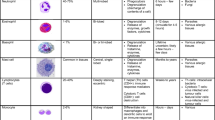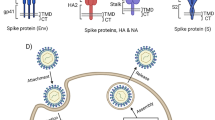Summary
Extracts of human lymphoblastoid cell lines derived from infectious mononucleosis patients and from normal individuals yielded an antigen, which was immunologically closely related, if not identical, to the soluble (S) antigen present in cell lines derived from Burkitt lymphoma patients. This antigen was found in both the EB virus-positive and EB virus-negative lines.
The S antigen was stable at 4° C over the period of one week, but at 37° C at least 50% of activity was lost in 24 hours. When heated for 30 minutes at 56° C or at higher temperatures, the antigen titer was reduced but some activity was still preserved even after heating at 80° C. The antigen was found to be trypsinsensitive but it was stable over the range of pH 5.0 to 8.2. No evidence was obtained thus far that more than one antigen reactive with human sera was present in the preparations tested.
The highest S antigen titers in EB 3 cells were formed after cultivation of these cells at 32° C, in P3J cells at 37° C. The P3J cells grew well at 40°C; at this temperature both the synthesis of S antigen and the formation of EB virus antigens detectable by immunofluorescence were preserved even after long-term cultivation. The cultivation of cells in arginine deprived media did not result in enhancement of either S antigen titer or percentage of cells positive by immunofluorescence.
Similar content being viewed by others
References
Benyesh-Melnick, M., C. F. Phillips, R. T. Lewis, andE. H. Seidel: Studies on acute leukemia and infectious mononucleosis of childhood. IV. Continuous propagation of lymphoblastoid cells from spontaneously transformed bone marrow cultures. J. nat. Cancer Inst.40, 123 (1968).
Black, P. H., W. P. Rowe, H. C. Turner, andR. J. Huebner: A specific complement-fixing antigen present in SV40 tumor and transformed cells. Proc. nat. Acad. Sci. (Wash.)50, 1148 (1963).
Gerber, P., J. Whang-Peng, andJ. H. Monroe: Transformation and chromosome changes induced by Epstein-Barr virus in normal human leukocyte cultures. Proc. nat. Acad. Sci. (Wash.)63, 740 (1969).
Henle, W., V. Diehl, G. Kohn, H. zur Hausen, andG. Henle: Herpes-type virus and chromosome marker in normal leukocytes after growth with irradiated Burkitt cells. Science157, 1064 (1967).
Henle, W., andG. Henle: Effect of arginine-deficient media on the herpes-type virus associated with cultured Burkitt tumor cells. J. Virol.2, 182 (1968).
Huebner, R. J., W. P. Rowe, H. C. Turner, andW. T. Lane: Specific adenovirus complement-fixing antigens in virus-free hamster and rat tumors. Proc. nat. Acad. Sci. (Wash.)50, 379 (1963).
Klein, G., P. Clifford, E. Klein, andJ. Stjernswärd: Search for tumorspecific immune reactions in Burkitt lymphoma patients by the membrane immunofluorescence reaction. Proc. nat. Acad. Sci. (Wash.)55, 1628 (1966).
Klein, G., G. Pearson, J. S. Nadkarni, E. Klein, P. Clifford, G. Henle, andW. Henle: Relationship between Epstein-Barr viral and cell membrane fluorescence of Burkitt tumor cells. I. Dependance of cell membrane fluorescence on presence of EB virus. J. exp. Med.128, 1011 (1968).
Pope, J. H., M. K. Horne, andE. J. Wetters: Significance of a complementfixing antigen associated with herpes-like virus and detected in the Raji cell line. Nature (Lond.)222, 186 (1969).
Pope, J. H., M. K. Horne, andW. Scott: Identification of the filtrable leukocytetransforming factor of QIMR-WIL cells as herpes-like virus. Intern. J. Cancer4, 255 (1969).
Porter, D. D., I. Wimberly, andM. Benyesh-Melnick: Prevalence of antibodies to EB virus and other herpes viruses. J. Amer. med. Assoc.208, 1675 (1969).
Report from Immunology Subgroup, Special Virus-Cancer Program: Results of a comparison of serological tests used to detect human antibodies to à herpesvirus (HLV) associated with Burkitt's lymphoma. J. nat. Cancer Inst.42, 623 (1969).
Vonka, V., D. D.Porter, R. M.McCombs, and M.Benyesh-Melnick: Studies with viral and soluble complement-fixing antigens from cultured Burkitt lymphoma cells. Bact. Proc, p. 154 (1969).
Vonka, V., M.Benyesh-Melnick, and R. M.McCombs: Antibodies in human sera to soluble and viral antigens found in Burkitt lymphoma and other lymphoblastoid cell lines. J. nat. Cancer Inst., in press (1970).
Weinberg, A., andY. Becker: Studies on EB virus of Burkitt's lymphoblasts. Virology39, 312 (1969).
Author information
Authors and Affiliations
Additional information
Dedicated to Professor Dr. Dr. C.Hallauer on the occasion of Ms 70th birthday.
This investigation was supported by research contract PH 43-68-678 from the Special Virus Cancer Program, and grant CA 04600, from the National Cancer Institute, National Institutes of Health.
Rights and permissions
About this article
Cite this article
Vonka, V., Benyesh-Melnick, M., Lewis, R.T. et al. Some properties of the soluble (S) antigen of cultured lymphoblastoid cell lines. Archiv f Virusforschung 31, 113–124 (1970). https://doi.org/10.1007/BF01241670
Received:
Issue Date:
DOI: https://doi.org/10.1007/BF01241670




